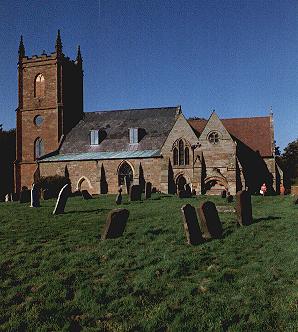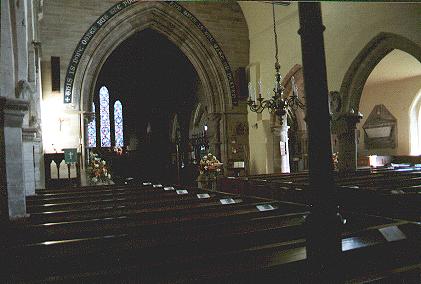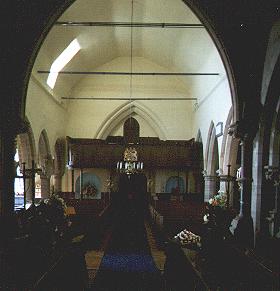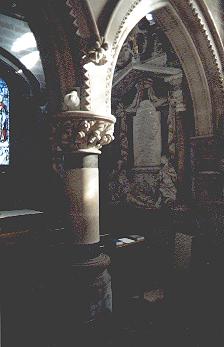
Travelling south from Bromsgrove on the B4091,there is a sign that points to the National Trust property "Hanbury Hall". I would advise anyone planning a visit to Hanbury via the B4090 to ignore the turning to the Hall and take the B4091, a one or two mile diversion, because there is an unforgettable view of the parish church high on its hill from this direction. This is how I "discovered" St Mary's church.

The church is the ancestral burial place of the Vernon family who owned the Hall. They have left their mark on the fabric of this church as well as their likenesses inside. The road climbs up steeply from the village and ends in front of the west tower of the church. If you are as lucky as me to arrive on a clear sunny day take a while to walk around the outside of the church and enjoy the stunning views from the churchyard across to Bredon Hill and the Cotswolds to the south, and the Severn Valley and the Malverns to the west. It lies in the former county of Worcestershire.
Outside the church appears to be a mix of two periods, Georgian Gothick of the C18 and Victorian Gothic of the C19. All is built with red sandstone. The tower is also the entrance porch, and has an ogee arch, Y-traceried window and bell openings, as well as circular windows: the parapet is embattled and there are crocketed pinnacles. The tower is a noble - if incorrect -attempt at imitating medieval Gothic at a time when most craftsmen were unfamiliar with its forms. the nave in contrast has large Gothic windows without tracery and there are dormer windows in the sweeping slated roof. There is also a blocked doorway on the south side. The Victorian parts collide with the rest with harsh robust detail and red tiled roofs to the chancel and transeptal side bays. One member of the Vernon family has his monument outside under a cusped recess.

The interior comes as somewhat of a surprise, because although there is the expected mix of Georgian features in the nave and High Victoriana in the eastern half, there are also medieval north and south arcades. The south arcade is the earliest, Transitional in style of c1210. The north arcade is much later Perpendicular work of later C15. Both nave and aisles have Georgian plaster ceilings. There is a west gallery and box pews of the late C18 (the former making it very difficult to photograph the interior).

The Victorian work is by G.E.Street 1860-1 and makes no attempt to harmonize. The details display a self confidence, from the chancel arch with its marble shafting and text over, to the painted wooden roofs and the slim piers on tall bases with over-sized capitals carrying pointed arches decorated with dog-tooth moulding. Even more contrasting is the juxta-position of fine Classical monuments, to members of the Vernon family.

The picture above shows the best monument in the church, that of Thomas Vernon (Builder of the Hall) d1722 by Edward Stanton and Christopher Horsnaile, white and grey marble with semi-reclining effigy with wig, and seated figures of Justice and Learning. another standing memorial against the west wall of the S transeptal chapel is to Bowater Vernon d1735 by Roubiliac with standing figure. At the entrance to the chapel in the south aisle is a hanging monument by Chantrey,1837, to Thomas Taylor Vernon with kneeling wife and two children.
In the N aisle are two panels of the Nativity and Resurrection by Walter Gilbert, the original models for the great rerdos in Liverpool Cathedral. The brass candelabrum in the nave dates from 1795.
One final piece of Trivia is that Hanbury church is also that of "St Stephen, Ambridge", well-known to listeners of the BBC Radio4 drama "The Archers". Three weddings were recorded here in 1955, 1988 and 1994.